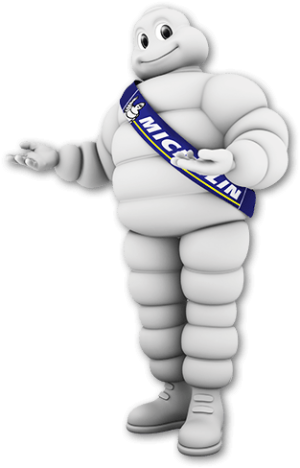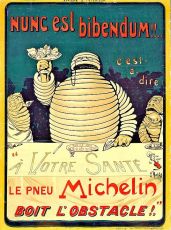The Michelin Man
The Bibendum, (French pronunciation: [bibɛ̃dɔm]), also known as the Michelin Man or Michelin Tire Man, serves as the official mascot of the Michelin tire company. This humanoid figure, made entirely of stacked white tires, was first introduced at the Lyon Exhibition of 1894, where the Michelin brothers showcased their stand. It has since become one of the world's oldest trademarks, still in active use. The iconic slogan "Nunc est bibendum," which translates to "Now is the time to drink," is derived from Horace's Odes (book I, ode xxxvii, line 1). Additionally, he is sometimes referred to as Bib or Bibelobis.
Michelin has been a dominant force in the French tire industry for decades, maintaining its status as a leading global tire manufacturer. The company's renowned guidebooks are a testament to its influence. Bibendum has been portrayed as a symbol of industry, mastery, and patriotism, embodying the French spirit. In the 1920s, he encouraged Frenchmen to embrace America's advanced factory system, while still valuing the "inferior" products of these factories. As automobiles became more accessible to the middle class, Michelin's advertising expanded to include a wider range of price points, including its restaurant and hotel guides. The concept of Bibendum was born during the Universal and Colonial Exposition in Lyon in 1894. Édouard and André Michelin were inspired by a display of tires that suggested the figure of a man without arms. Four years later, André met French cartoonist Marius Rossillon, better known as O'Galop, who presented him with an image of a rejected character from a Munich brewery. This figure, depicted holding a large glass of beer and quoting Horace's phrase "Nunc est bibendum," became the foundation of Michelin's symbol. Today, Bibendum is recognized globally, representing Michelin in over 150 countries. The original poster from 1898 featured Bibendum extending a toast to his competitors, Brand X, with a glass filled with road hazards, under the title "C'est à dire : À votre santé. Le pneu Michelin boit l'obstacle." The glass was filled with nails and broken glass, symbolizing Michelin tires' ability to easily overcome road hazards. For 15 years, this basic poster design was used, with new products being added to the table in front of Bibendum. The exact year the name "Bibendum" was chosen remains uncertain, but it is believed to have been around 1908 when Michelin commissioned Curnonsky to write a newspaper column under that name. In 1922, Michelin held a contest in the United States to name the character.
The original rubber tires were either gray-white or light, almost translucent beige. However, in 1912, they underwent a transformation when carbon was incorporated into them, serving both as a preservative and a strengthening agent. Consequently, the company, Bibendum, also adopted this change, portraying him in several print advertisements with a black appearance. The decision to revert to the original color was made due to concerns over printing and aesthetics, rather than racial considerations, which is often misunderstood. The image of the plump tire-man has been used metaphorically to describe individuals who are obese or those who wear excessively bulky clothing, such as "How can I stay warm without looking like the Michelin Man?" Over the years, Bibendum's appearance has evolved. The logo of O'Galop, which was inspired by bicycle tires, featured him wearing pince-nez glasses and smoking a cigar. By the 1960s, Bibendum was depicted in a more active role, often seen running and rolling a tire, and had given up smoking. In celebration of his 100th anniversary in 1998, Bibendum was portrayed in a more streamlined version, without glasses, to reflect the more compact and lower-profile tires found in modern vehicles. Additionally, a computer-animated version of Bibendum has made an appearance in American television ads,
Commercials


